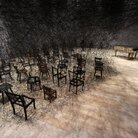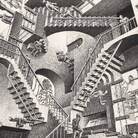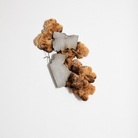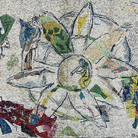Elmgreen & Dragset. Useless Bodies?

© Elmgreen & Dragset | Elmgreen & Dragset, What’s Left?, 2021. Silicone, clothing, wire rope, balancing pole. Dimensions variable I Ph. Elmar Vestner
Dal 31 March 2022 al 22 August 2022
Milano
Luogo: Fondazione Prada
Indirizzo: Largo Isarco 2
Sito ufficiale: http://fondazioneprada.org
Fondazione Prada presenta “Useless Bodies?”, una mostra del duo di artisti Elmgreen & Dragset, a Milano dal 31 marzo al 22 agosto 2022.
“Useless Bodies?” è una delle indagini tematiche più estese mai realizzate da Fondazione Prada. Concepita per quattro spazi espositivi e il cortile della sede milanese, per un totale di oltre 3.000 m2, la mostra esplora la condizione del corpo nell’era post-industriale, in cui la nostra presenza fisica sembra avere perso la sua centralità tanto da risultare ormai superflua. Questo mutamento ha un impatto su ogni aspetto della nostra vita: dalle condizioni di lavoro alla salute fino alle relazioni interpersonali e al modo in cui registriamo le informazioni. Il progetto affronta anche le modalità con cui gli individui si adattano fisicamente a un mondo sempre più dominato da un immaginario bidimensionale, in particolare in riferimento dell’attuale pandemia.
Come hanno dichiarato Elmgreen & Dragset, “I nostri corpi non sono più i soggetti attivi delle nostre esistenze. Diversamente da quanto accadeva nell’era industriale, oggi non generano più valore all’interno degli avanzati meccanismi produttivi tipici della società contemporanea. Si potrebbe addirittura affermare che le nostre identità fisiche siano diventate più un ostacolo che un vantaggio. Nel 19° secolo il corpo produceva i beni di consumo, mentre nel secolo successivo ha assunto prevalentemente il ruolo di consumatore. Nel primo ventennio del 21° secolo il corpo detiene lo status di prodotto i cui dati vengono raccolti e venduti dalle Big Tech. In un’epoca in cui la mercificazione dei dati personali da parte delle aziende tecnologiche è di dominio pubblico – seppur inutilmente – e l’influenza di queste organizzazioni su ogni aspetto della nostra vita è sempre più dilagante, ci fa un po' paura pensare al ruolo futuro dei nostri corpi.”
La percezione del corpo è un tema centrale per Elmgreen & Dragset e attraversa molti aspetti della loro pratica scultorea e performativa. Nel corso della loro carriera, gli artisti hanno infatti affrontato questioni centrali come la crescita, l’intimità, l’identità, i diversi modi di vivere e di percorrere la dimensione pubblica.
Seguendo un percorso espositivo che da i due piani del Podium si sviluppa nella galleria Nord e nella Cisterna, il pubblico incontra una sequenza di installazioni immersive. La sede milanese di Fondazione Prada si trasforma quindi in una pluralità di universi identificati da atmosfere, estetiche e temi specifici.
Al piano terra del Podium, sculture classiche e neoclassiche sono associate a opere di Elmgreen & Dragset per formare una costellazione di lavori provenienti da epoche diverse. Ispirata alla mostra “Serial Classic”, curata nel 2015 da Salvatore Settis e progettata da Rem Koolhaas in occasione dell’inaugurazione della sede di Milano di Fondazione Prada, la sovrapposizione di sculture storiche e contemporanee mette in luce similitudini e differenze nelle modalità di riproduzione del corpo umano attraverso la pratica scultorea degli artisti nei diversi secoli. In questa sezione Elmgreen & Dragset hanno sviluppato un complesso sistema di rimandi che dà vita a un dialogo tra antico e contemporaneo, a testimonianza del fatto che – come ha affermato lo scrittore e drammaturgo americano William Faulkner – “il passato non è mai morto. In realtà non è neppure passato”.
Il secondo piano del Podium è invece convertito in un ampio ufficio abbandonato, un’immagine legata al mutamento del ruolo del corpo nel contesto professionale. L’installazione consiste nella ripetizione di file infinite di postazioni lavorative, un richiamo alle strutture geometriche tipiche della scultura minimalista. L’ambiente evoca inoltre scenografie di film distopici come Playtime (1967) di Jacques Tati e Brazil (1985) di Terry Gilliam.
Nella galleria Nord il pubblico si immerge nella visione futuristica di un ambiente domestico: un’inquietante fusione tra un bunker, un’astronave e un laboratorio che costituisce una dimora inabitabile di estrema vanità. L’aspetto neutro e disumanizzato di questo spazio, sottolineato da oggetti dallo stile rigoroso, ci interroga sull’esistenza all’interno delle nostre abitazioni, soprattutto in un momento caratterizzato da una tecnologia sempre più pervasiva. Come una sorta di detective o di ospite inatteso, il visitatore è libero di esplorare lo spazio, raccogliere indizi e immaginare storie in un ambiente alienante simile a un film di fantascienza in cui l’unica presenza in movimento è quella di un cane robot.
Nella Cisterna Elmgreen & Dragset esplorano come le industrie del benessere, del tempo libero e della salute ci spingano a uniformarci a nuovi ideali fisici. I tre spazi della Cisterna diventano ambienti simili a spa desolate con una piscina e uno spogliatoio ormai in disuso. Mentre le innovazioni tecnologiche rendono i nostri corpi sempre più inutili, questi settori in continua espansione offrono infinite soluzioni innovative per “risolvere il problema del corpo imperfetto”. L’ambiente centrale include una nuova opera, What’s Left?, che può essere interpretata come una rappresentazione del corpo che esita a trovare il proprio ruolo di attore politico o strumento di cambiamento sociale.
Il tema del controllo fisico imposto al nostro corpo nella sfera pubblica è esplorato da alcune sculture di Elmgreen & Dragset allestite negli spazi esterni della Fondazione Prada. Le opere si configurano come sottili alterazioni di oggetti di uso quotidiano che diventano inutilizzabili per i loro scopi usuali. Spingono il visitatore a ripensare l’ordinario ed enfatizzano il modo in cui ognuno di noi mette in discussione i meccanismi di sorveglianza tipici degli spazi pubblici.
Fondazione Prada pubblicherà un volume di 500 pagine dal titolo Useless Bodies?, concepito più come un’estensione tematica della mostra piuttosto che come un tradizionale catalogo. Il libro raccoglie un’antologia di testi scritti attraverso molteplici prospettive: oltre 35 autori tra filosofi, artisti, scrittori, scienziati e pensatori indagano le mutevoli percezioni del corpo e la sua condizione nel nostro presente.
Gli artisti Michael Elmgreen (1961, Copenaghen, Danimarca) e Ingar Dragset (1969, Trondheim, Norvegia) vivono a Berlino e lavorano come duo dal 1995.
Elmgreen & Dragset hanno tenuto mostre personali in istituzioni di tutto il mondo, tra cui EMMA – Espoo Museum of Modern Art, Espoo (2020); The Nasher Sculpture Center, Dallas (2019-20); The Whitechapel Gallery, Londra (2018–2019); Tel Aviv Museum of Art (2016); UCCA, Pechino (2016); PLATEAU, Samsung Museum of Art, Seul (2015); Astrup Fearnley Museet, Oslo (2014); Victoria and Albert Museum, Londra (2013–14); Museum Boijmans Van Beuningen, Rotterdam (2011); ZKM Museum of Modern Art, Karlsruhe (2010); Museo de Arte Contemporáneo de Castilla y León (2009); Serpentine Gallery, Londra (2006); Tate Modern, Londra (2004) e Kunsthalle Zürich (2001).
Elmgreen & Dragset hanno partecipato alle biennali di Bangkok (2018), Istanbul (2013, 2011, 2001), Liverpool (2012), Singapore (2011), Mosca (2011, 2007), Venezia (2009, 2003), Gwangju (2006, 2002), San Paolo (2002) e Berlino (1998). Nel 2009 hanno ricevuto una menzione speciale per il progetto “The Collectors”, realizzato per i Padiglioni dei Paesi Nordici e della Danimarca, in occasione della 53. Biennale di Venezia. Nel 2017 Elmgreen & Dragset hanno inoltre curato la 15. Biennale di Istanbul.
Selezionati per l’Hugo Boss Prize, Guggenheim Museum, New York (2000), Elmgreen & Dragset sono stati insigniti del Preis der Nationalgalerie, Hamburger Bahnhof, Berlino (2002). Nel 2012 gli artisti sono stati scelti dalla London’s Fourth Plinth Commission a Trafalgar Square. Nel 2015 hanno ricevuto dottorati onorari dalla Norwegian University of Science and Technology e nel 2020 il B.Z.-Kulturpreis a Berlino. Nel 2021 sono stati premiati con il 14th Robert Jacobsen Prize della Würth Foundation, Künzelsau, Germania.
“Useless Bodies?” è una delle indagini tematiche più estese mai realizzate da Fondazione Prada. Concepita per quattro spazi espositivi e il cortile della sede milanese, per un totale di oltre 3.000 m2, la mostra esplora la condizione del corpo nell’era post-industriale, in cui la nostra presenza fisica sembra avere perso la sua centralità tanto da risultare ormai superflua. Questo mutamento ha un impatto su ogni aspetto della nostra vita: dalle condizioni di lavoro alla salute fino alle relazioni interpersonali e al modo in cui registriamo le informazioni. Il progetto affronta anche le modalità con cui gli individui si adattano fisicamente a un mondo sempre più dominato da un immaginario bidimensionale, in particolare in riferimento dell’attuale pandemia.
Come hanno dichiarato Elmgreen & Dragset, “I nostri corpi non sono più i soggetti attivi delle nostre esistenze. Diversamente da quanto accadeva nell’era industriale, oggi non generano più valore all’interno degli avanzati meccanismi produttivi tipici della società contemporanea. Si potrebbe addirittura affermare che le nostre identità fisiche siano diventate più un ostacolo che un vantaggio. Nel 19° secolo il corpo produceva i beni di consumo, mentre nel secolo successivo ha assunto prevalentemente il ruolo di consumatore. Nel primo ventennio del 21° secolo il corpo detiene lo status di prodotto i cui dati vengono raccolti e venduti dalle Big Tech. In un’epoca in cui la mercificazione dei dati personali da parte delle aziende tecnologiche è di dominio pubblico – seppur inutilmente – e l’influenza di queste organizzazioni su ogni aspetto della nostra vita è sempre più dilagante, ci fa un po' paura pensare al ruolo futuro dei nostri corpi.”
La percezione del corpo è un tema centrale per Elmgreen & Dragset e attraversa molti aspetti della loro pratica scultorea e performativa. Nel corso della loro carriera, gli artisti hanno infatti affrontato questioni centrali come la crescita, l’intimità, l’identità, i diversi modi di vivere e di percorrere la dimensione pubblica.
Seguendo un percorso espositivo che da i due piani del Podium si sviluppa nella galleria Nord e nella Cisterna, il pubblico incontra una sequenza di installazioni immersive. La sede milanese di Fondazione Prada si trasforma quindi in una pluralità di universi identificati da atmosfere, estetiche e temi specifici.
Al piano terra del Podium, sculture classiche e neoclassiche sono associate a opere di Elmgreen & Dragset per formare una costellazione di lavori provenienti da epoche diverse. Ispirata alla mostra “Serial Classic”, curata nel 2015 da Salvatore Settis e progettata da Rem Koolhaas in occasione dell’inaugurazione della sede di Milano di Fondazione Prada, la sovrapposizione di sculture storiche e contemporanee mette in luce similitudini e differenze nelle modalità di riproduzione del corpo umano attraverso la pratica scultorea degli artisti nei diversi secoli. In questa sezione Elmgreen & Dragset hanno sviluppato un complesso sistema di rimandi che dà vita a un dialogo tra antico e contemporaneo, a testimonianza del fatto che – come ha affermato lo scrittore e drammaturgo americano William Faulkner – “il passato non è mai morto. In realtà non è neppure passato”.
Il secondo piano del Podium è invece convertito in un ampio ufficio abbandonato, un’immagine legata al mutamento del ruolo del corpo nel contesto professionale. L’installazione consiste nella ripetizione di file infinite di postazioni lavorative, un richiamo alle strutture geometriche tipiche della scultura minimalista. L’ambiente evoca inoltre scenografie di film distopici come Playtime (1967) di Jacques Tati e Brazil (1985) di Terry Gilliam.
Nella galleria Nord il pubblico si immerge nella visione futuristica di un ambiente domestico: un’inquietante fusione tra un bunker, un’astronave e un laboratorio che costituisce una dimora inabitabile di estrema vanità. L’aspetto neutro e disumanizzato di questo spazio, sottolineato da oggetti dallo stile rigoroso, ci interroga sull’esistenza all’interno delle nostre abitazioni, soprattutto in un momento caratterizzato da una tecnologia sempre più pervasiva. Come una sorta di detective o di ospite inatteso, il visitatore è libero di esplorare lo spazio, raccogliere indizi e immaginare storie in un ambiente alienante simile a un film di fantascienza in cui l’unica presenza in movimento è quella di un cane robot.
Nella Cisterna Elmgreen & Dragset esplorano come le industrie del benessere, del tempo libero e della salute ci spingano a uniformarci a nuovi ideali fisici. I tre spazi della Cisterna diventano ambienti simili a spa desolate con una piscina e uno spogliatoio ormai in disuso. Mentre le innovazioni tecnologiche rendono i nostri corpi sempre più inutili, questi settori in continua espansione offrono infinite soluzioni innovative per “risolvere il problema del corpo imperfetto”. L’ambiente centrale include una nuova opera, What’s Left?, che può essere interpretata come una rappresentazione del corpo che esita a trovare il proprio ruolo di attore politico o strumento di cambiamento sociale.
Il tema del controllo fisico imposto al nostro corpo nella sfera pubblica è esplorato da alcune sculture di Elmgreen & Dragset allestite negli spazi esterni della Fondazione Prada. Le opere si configurano come sottili alterazioni di oggetti di uso quotidiano che diventano inutilizzabili per i loro scopi usuali. Spingono il visitatore a ripensare l’ordinario ed enfatizzano il modo in cui ognuno di noi mette in discussione i meccanismi di sorveglianza tipici degli spazi pubblici.
Fondazione Prada pubblicherà un volume di 500 pagine dal titolo Useless Bodies?, concepito più come un’estensione tematica della mostra piuttosto che come un tradizionale catalogo. Il libro raccoglie un’antologia di testi scritti attraverso molteplici prospettive: oltre 35 autori tra filosofi, artisti, scrittori, scienziati e pensatori indagano le mutevoli percezioni del corpo e la sua condizione nel nostro presente.
Gli artisti Michael Elmgreen (1961, Copenaghen, Danimarca) e Ingar Dragset (1969, Trondheim, Norvegia) vivono a Berlino e lavorano come duo dal 1995.
Elmgreen & Dragset hanno tenuto mostre personali in istituzioni di tutto il mondo, tra cui EMMA – Espoo Museum of Modern Art, Espoo (2020); The Nasher Sculpture Center, Dallas (2019-20); The Whitechapel Gallery, Londra (2018–2019); Tel Aviv Museum of Art (2016); UCCA, Pechino (2016); PLATEAU, Samsung Museum of Art, Seul (2015); Astrup Fearnley Museet, Oslo (2014); Victoria and Albert Museum, Londra (2013–14); Museum Boijmans Van Beuningen, Rotterdam (2011); ZKM Museum of Modern Art, Karlsruhe (2010); Museo de Arte Contemporáneo de Castilla y León (2009); Serpentine Gallery, Londra (2006); Tate Modern, Londra (2004) e Kunsthalle Zürich (2001).
Elmgreen & Dragset hanno partecipato alle biennali di Bangkok (2018), Istanbul (2013, 2011, 2001), Liverpool (2012), Singapore (2011), Mosca (2011, 2007), Venezia (2009, 2003), Gwangju (2006, 2002), San Paolo (2002) e Berlino (1998). Nel 2009 hanno ricevuto una menzione speciale per il progetto “The Collectors”, realizzato per i Padiglioni dei Paesi Nordici e della Danimarca, in occasione della 53. Biennale di Venezia. Nel 2017 Elmgreen & Dragset hanno inoltre curato la 15. Biennale di Istanbul.
Selezionati per l’Hugo Boss Prize, Guggenheim Museum, New York (2000), Elmgreen & Dragset sono stati insigniti del Preis der Nationalgalerie, Hamburger Bahnhof, Berlino (2002). Nel 2012 gli artisti sono stati scelti dalla London’s Fourth Plinth Commission a Trafalgar Square. Nel 2015 hanno ricevuto dottorati onorari dalla Norwegian University of Science and Technology e nel 2020 il B.Z.-Kulturpreis a Berlino. Nel 2021 sono stati premiati con il 14th Robert Jacobsen Prize della Würth Foundation, Künzelsau, Germania.
SCARICA IL COMUNICATO IN PDF
COMMENTI

-
 Dal 24 October 2025 al 1 March 2026
Saluzzo | La Castiglia
Dal 24 October 2025 al 1 March 2026
Saluzzo | La Castiglia
Ferdinando Scianna. La moda, la vita
-
 Dal 22 October 2025 al 28 June 2026
Torino | MAO – Museo d'Arte Orientale
Dal 22 October 2025 al 28 June 2026
Torino | MAO – Museo d'Arte Orientale
Chiharu Shiota. The Soul Trembles
-
 Dal 23 October 2025 al 1 March 2026
Reggio di Calabria | Palazzo della Cultura P. Crupi
Dal 23 October 2025 al 1 March 2026
Reggio di Calabria | Palazzo della Cultura P. Crupi
M.C. Escher
-
 Dal 24 October 2025 al 3 May 2026
Roma | Scuderie del Quirinale
Dal 24 October 2025 al 3 May 2026
Roma | Scuderie del Quirinale
Tesori dei Faraoni
-
 Dal 19 October 2025 al 27 November 2025
Roma | MAXXI Museo nazionale delle arti del XXI secolo
Dal 19 October 2025 al 27 November 2025
Roma | MAXXI Museo nazionale delle arti del XXI secolo
Chris Soal. Spillovers: Notes on a Phenomenological Ecology
-
 Dal 18 October 2025 al 18 January 2026
Ravenna | MAR – Museo d’Arte della città di Ravenna
Dal 18 October 2025 al 18 January 2026
Ravenna | MAR – Museo d’Arte della città di Ravenna
Chagall in mosaico. Dal progetto all’opera


